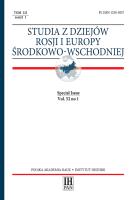The Iron Curtain as an Aspect of the Sovietisation of Eastern Europe in 1949–1953
The Iron Curtain as an Aspect of the Sovietisation of Eastern Europe in 1949–1953
Author(s): Paweł BielickiSubject(s): Diplomatic history, Political history, WW II and following years (1940 - 1949), Post-War period (1950 - 1989)
Published by: Instytut Historii im. Tadeusza Manteuffla Polskiej Akademii Nauk
Keywords: Eastern Europe history;Cominform;Sovietisation;Cold War in Europe;Iron Curtain;CMEA;
Summary/Abstract: Sovietisation of Eastern Europe by the Soviet Union at the turn of the 1950s was a consequence of the division of Europe and strengthened the so-called Iron Curtain. The restrictions of the Iron Curtain included the ban on all travel to the West, except of delegations of sportsmen and some of the members of security services of those countries. Rapid Sovietisation made the nations subjected by the Soviet Union realise how helpless they were and how impossible it was to oppose such a reign of permanent terror of all social groups hostile to communism. Societies became apathetic, passive and submissive to the USSR, seeing it as the only possibility of existence. It is related to one of principal purposes of Sovietisation at the end of the Stalinist period, quite oft en neglected: its consequences for the social development of subsequent generations of indoctrinated societies. The period of Iron Curtain led to the growing civilisation and mentality distance between East-European countries and the West. The implementation of the Marshall Plan and some basis of economic integration of the countries members of the European Coal and Steel Community in the 1950s contributed to an enormous rise of the standard of living, contrary to the states under communist control. For many decades Sovietisation destroyed the generations able to criticise the authorities, but also willing to cooperate with the state. It contributed to a multi-layered demoralisation of societies. Some of social customs of those times, such as robbing the state through tax avoidance or embezzlement of public money through obtaining social allowances under false pretence, are still present in contemporary post-communist states. Taking of some features of the Russian despotism, such as mistrust, envy, contempt for the weak, or egoism, perpetuated many stereotypes of people from Eastern Europe. The division of the world made by the Big Three and sealed during the Stalinist period made it impossible for the Eastern European nations to know new currents of thoughts, and significantly limited their sense of independence and ability to make independent decisions. Consequences of this process are still present in various dimensions of socio-cultural and political life.
Journal: Studia z Dziejów Rosji i Europy Środkowo-Wschodniej
- Issue Year: 52/2017
- Issue No: 1
- Page Range: 137-161
- Page Count: 25
- Language: English

